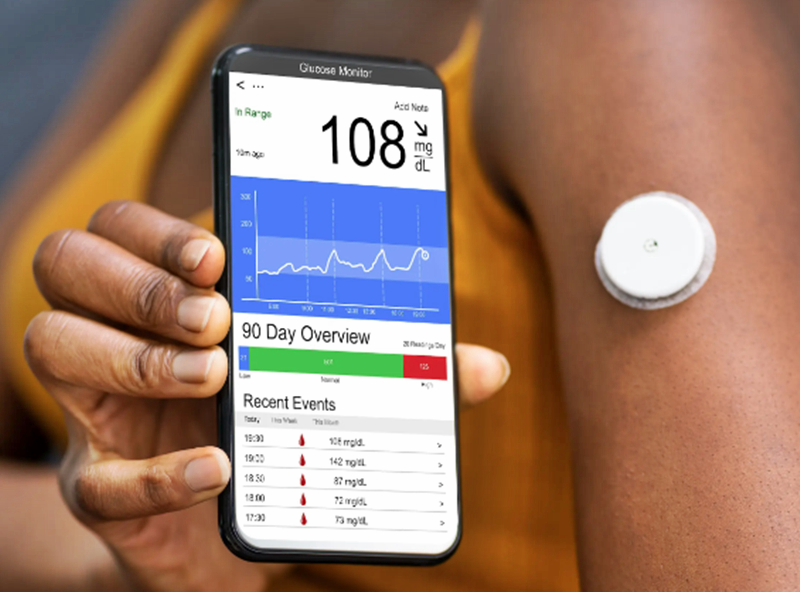Real-Time Blood Sugar Monitoring: A Troubling Trend Or Health Hack?

By EpochTimes - Sheramy Tsai - January 18, 2024
The popularity of these devices is expanding beyond diabetes management but the benefits are debated.
Her experience underscores a growing trend of people without diabetes monitoring their blood sugar, either out of concern over disease or to optimize their health. But while these devices can offer valuable insight, many people may not need them and could suffer unneeded expense and stress from using them, experts warn.
CGMs Demystified
Continuous glucose monitors (CGMs) are small, wearable devices that provide real-time data on blood sugar with a sensor typically placed on the arm or abdomen.
Unlike traditional fingerstick tests, CGMs don’t require repeated skin punctures. CGMs gauge glucose in the interstitial fluid—the fluid between body tissues. The collected data is wirelessly relayed to a user’s choice of device, be it to a smartphone app, a watch, or directly to an insulin pump, typically every five minutes or about 288 times a day.

Continuous glucose monitors were once reserved for people with diabetes, but more and more health-conscious people are wearing them as a way to monitor their blood sugar.(Dragoljub Bankovic/Shutterstock)
“At their core, CGMs provide knowledge, and knowledge is power. Any person wearing a CGM can better understand how different foods and activities affect their glucose levels,” Dr. Andrew Demidowich, assistant professor in the Division of Endocrinology at Johns Hopkins Medicine, told The Epoch Times.
Not everyone shares Dr. Demidowich’s enthusiasm.
The Central Role of Glucose in Metabolic Health
Glucose, a simple sugar, is a key fuel source for the body, but it creates problems if it builds up in the blood. High blood glucose is more than just a marker for diabetes—it’s a central player in poor metabolic health. Metabolic diseases, which include diabetes, obesity, and heart disease, are increasing globally. The Centers for Disease Control and Prevention highlights that more than one-third of U.S. adults suffer from a cluster of conditions known as metabolic syndrome, which includes high blood pressure, high blood sugar, excess body fat around the waist, and abnormal cholesterol levels.
Processed foods, including refined grains and sugars, as well as an increasingly sedentary lifestyle are wreaking havoc on people’s metabolic health. The rise of diabetes and obesity have been linked to processed foods that cause significant spikes in blood sugar. And while exercise can help manage these effects, especially after eating, many people prefer more passive forms of entertainment.

(The Epoch Times)
Rapid fluctuations in glucose can stress the body and trigger inflammation, which can lead to chronic diseases such as heart disease, arthritis, and certain cancers. Watching glucose levels can help people understand what improves their blood sugar level—and what makes it worse.
“I often tell my patients that we are all unique, and how one person’s sugar levels react to a certain food, like a banana or orange, may be completely different in how it may affect another person,” Dr. Demidowich said.
CGMs for All
CGMs were once limited to diabetes care. Initially vital for the 1.9 million Americans with Type 1 diabetes requiring daily monitoring, CGMs are now being used by a much broader demographic. This shift is significant in a nation in which an estimated 38 million people live with diabetes.

Continuous glucose monitors are small devices that measure glucose in the interstitial fluid using a small sensor probe. (Illustration by The Epoch Times/Shutterstock)
CGMs can provide real-time insights into the effects of lifestyle choices on glucose levels. Diet is just one of the many factors affecting glucose levels—exercise, stress, sleep, illness, dehydration, and pain also play significant roles.
More people are using CGMs as a way to self-optimize their health and make better decisions about food, physical activity, and more. The growing use of CGMs signifies a shift toward personalized, data-driven health and wellness strategies.

A 2018 Stanford University study, led by professor Michael Snyder, uncovered frequent and previously undetected blood sugar spikes in healthy individuals.“There are lots of folks running around with their glucose levels spiking, and they don’t even know it,” Mr. Snyder said in a statement, underscoring the risk these spikes pose for cardiovascular disease and insulin resistance, a diabetes precursor.
The study, using CGMs on participants, suggests that even those without diabetes can experience significant glucose fluctuations.
“We think that these continuous glucose monitors will be important in providing the right information earlier on so that people can make changes to their diet should they need to,” Mr. Snyder said.
Echoing these potential benefits, a related study by George Washington University researchers found that 90 percent of

CGM users reported shifts toward healthier living, with nearly 50 percent of them more inclined to exercise after noticing blood glucose spikes and 87 percent modifying their diets based on feedback from their devices.
Dr. Demidowich has seen these effects himself, which is why he encourages patients with prediabetes to use the devices.
“I’m a big proponent of people with prediabetes wearing a CGM, even if just for a short time like 2 to 4 weeks, to better understand how to optimize their lifestyle and diet to avoid progression to diabetes,” he told The Epoch Times.
Real-time data can change patient behavior, he said.
“As providers, we can recommend cutting out sugary beverages or processed foods, but when patients see their sugar levels spiking in real-time, that becomes a powerful impetus for change.”
Too Much Information?
However, not everyone shares this enthusiasm for widespread CGM use. Dr. Robert H. Shmerling, senior faculty editor at Harvard Health Publishing, raises an issue with the devices’ utility for non-diabetics. He says there isn’t conclusive research demonstrating benefits for this group, pointing out that most people without diabetes naturally maintain normal blood sugar levels.
“Just because you can measure something doesn’t mean you should,” Dr. Shmerling wrote in an article. CGM use in the non-diabetic population may be premature and driven more by marketing than medical necessity, he cautioned. He noted that unnecessary monitoring could lead to false alarms, increased anxiety, and possibly harmful interventions.

Some people simply don’t know what healthy blood sugar looks like, and that can lead to confusion and fear, which can undermine, rather than improve, health.
Dr. Shmerling’s skepticism is echoed by 70-year-old Bob Volat, a Type 1 diabetes patient since age 59 who praises CGMs as a transformative tool in his health journey, calling them “an absolute gift.”
However, in a conversation with The Epoch Times, Mr. Volat questioned the utility of such advanced technology for nondiabetics, viewing it as overly complex and potentially motivated by profit. The devices aren’t cheap and he believes people may be swayed by aggressive marketing.
Rather than purchasing devices, he advises that people take a more holistic approach to health that goes beyond a singular focus on glucose levels.
Decoding Blood Sugar: Understanding Spikes and Glucose Tolerance
Prediabetes and diabetes are diagnosed based on specific blood glucose levels and A1C test results. The A1C test, measuring average blood sugar over two to three months, offers a comprehensive view of long-term glucose control.
Beyond these diagnostic benchmarks, there’s an increasing focus on the intricacies of blood sugar regulation, especially the health impacts of frequent sugar spikes, which CGM devices can adeptly identify.
Early Warning Signs of Diabetes Hidden in Everyday

COVID-19 Boosters Linked to Blood Sugar Spikes in People With Type 1

Mario Kratz, a distinguished nutrition and chronic disease researcher, shares insights on managing blood sugar on his Nourished by Science website.
Most people don’t understand what their blood sugar levels should look like, and even the science is unclear, he cautions.
“It’s important to be clear that there is no scientific or clinical definition of a blood sugar spike,” Mr. Kratz told The Epoch Times. “As a result, some people on social media have started to call a small bump in blood sugar of 30 mg/dL or more a spike. That would be from a fasting of 90 mg/dL to 120 mg/dL after a meal. That is, in my opinion, not a reasonable definition, because fluctuations between 70 and 140 mg/dL are normal, even in the most healthy and most glucose-tolerant people.”
He recommends a maintenance level within the 70 to 140 mg/dL range and sets a significant threshold for blood sugar spikes.
“Our suggested definition of a blood sugar spike that we may want to avoid is any increase in blood glucose concentrations to 180 mg/dL (10 mmol/L) or higher,” he said, noting that frequent spikes could indicate glucose intolerance.

As blood sugar ranges increase, the net benefit of lowering blood sugar also increases. (The Epoch Times)
“Data suggests that CGM glucose concentrations exceeding 140 mg/dL (7.8 mmol/L) are rare in healthy, young, and lean individuals with truly normal glucose tolerance, and levels greater than 180 mg/dL (10 mmol/L) rarely occur.
“Blood sugar spikes are negative if they trigger reactive hypoglycemic episodes and/or if the time above 180 mg/dL is substantial enough that it leads to long-term negative health consequences.”
It’s also essential to monitor overall trends, not just individual spikes. Defects in blood sugar regulation often develop gradually. Sometimes, it isn’t even the spike that matters, but how long it takes for blood sugar to come back down.

Certain foods and insulin resistance can cause blood sugar to spike and crash, a rollercoaster that can lead to several health issues. (The Epoch Times)
Lucrative Prospects in the CGM Market
The growing number of people with diabetes and prediabetes aren’t the only ones concerned about their blood sugar. As health literacy grows, more people are going beyond trying to avoid disease, working instead to optimize their health and live as long as possible. They’re monitoring their weight, heart rate variability, and sleep patterns.
For them, monitoring blood sugar is just one more way to check on their overall health. This may be partly why Dexcom Inc. broadened its mission last year from solely diabetes management to encompass general health. Dexcom is one of the handful of companies making CGMs.The expanding global base of CGM users is now estimated at approximately 7 million.

This booming market is led by industry giants such as Abbott and Dexcom. Abbott’s Diabetes Care division achieved global sales of $4.33 billion in 2021. Dexcom, focusing exclusively on CGMs, raised its revenue from $2.4 billion in 2021 to $2.9 billion in 2022, catering to 1.7 million users worldwide. As the CGM market grows, companies such as Signos Inc. are making their mark.
With recent funding of $20 million, the five-year-old firm has launched an app that works with Dexcom’s CGMs. Signos is gaining popularity, telling The Epoch Times that more than 89 percent of users report losing weight within their first 30 days of using the program. Competing closely with Signos is Nutrisense, reporting $40.5 million in 2023 revenue. It employs Abbott’s FreeStyle Libre, offering varied choices in the CGM market.
Other key players include Levels Health, with more than 50,000 members, and Supersapiens, targeting athletes for hypoglycemia prevention. Retail expansion is evident, as Best Buy is set to stock the Dexcom G7 soon.
CGMs: A Pricey Tool Beyond Reach for Many
While companies in the CGM sector reap significant profits, the steep costs of these devices render them unaffordable for many. The sensors, needing replacement every 10 to 14 days, can cost consumers approximately $40 per month with insurance, and without coverage, this expense can escalate to as much as $500 monthly.
Janet Arculeo VanBurger, 71, a nurse with diabetes, illustrates the issue. When her glucose levels dangerously spiked in July 2023, her doctor recommended a CGM. Initially, her non-insulin treatment disqualified her from insurance coverage. Even after securing an Abbott discount, she incurs $253.34 every three months for CGM supplies. Adding to her frustration, she began insulin therapy three weeks after getting the CGM, yet her insurance continues to deny coverage.
Ms. VanBurger’s case highlights a larger concern: CGM affordability aggravates health disparities. Access largely depends on financial capability, leading to a widening gap between individuals who can and cannot afford these advanced monitoring technologies.
“Fortunately, right now, I can afford it,” Ms. VanBurger said. “That can change in a heartbeat.”
Navigating the Data Dilemma in Nondiabetic Health
In an era when health data is more accessible than ever, the use of CGMs and similar devices epitomizes the double-edged sword of continuous health monitoring. On one hand, these technologies fill crucial gaps in a healthcare system struggling to provide personalized, preventative care.
For many, CGMs offer insights into metabolic health that would otherwise go unnoticed, potentially aiding in early detection and management of conditions such as prediabetes. This empowerment through data, especially in a system often reactive rather than proactive, is invaluable.
Dr. Demidowich compares the public’s uptake of CGMs to smartwatch heart rate monitors, noting their significance in boosting health engagement and awareness.
“Lifestyle and diet play such an oversized role in our overall health, and most of us are truthfully ‘stumbling in the dark,’” he said.
CGMs offer immediate feedback, shedding light on the effects of daily habits, such as poor sleep or diet, and guiding users toward healthier decisions.

On the other hand, this abundance of data can overwhelm people, potentially causing heightened anxiety and stress. Though enlightening, the incessant flow of health information may foster an unhealthy obsession with constant health metrics. This overload can trigger hypervigilance and undue concern over normal physiological fluctuations in some individuals.
“Some people may get undue anxiety and stress from constantly seeing their sugar levels update every several minutes,” Dr. Demidowich said.
The challenge lies in striking a balance—utilizing health data to enhance well-being without falling into the trap of over-monitoring and the stress it can bring. In the context of CGMs and broader health-tracking tools, discerning the line between helpful vigilance and detrimental data obsession becomes crucial for both physical and mental health.
Balancing Insight With Education in CGM Use
For those exploring CGM technology, education and moderation are essential. Individuals with diabetes often receive guidance from endocrinologists, but people without the condition may not have access to this level of specialized support. Relying on primary care physicians may not be enough, as these doctors often lack the time or expertise to help interpret CGM data effectively.
Dr. Demidowich underscores the importance of patient education: “If your patient doesn’t know what to do with the knowledge, then what good is it?” He emphasizes that healthcare providers must actively engage and empower their patients in interpreting CGM data, a key factor in the device’s effective use.
Dr. Demidowich also recognizes the systemic challenges restricting healthcare providers from dedicating ample time to patient education. He suggests that healthcare professionals should arm themselves with educational materials or direct patients to external resources for a thorough understanding and guidance.
In this context, moderation in CGM use becomes critical. By employing these devices for a specific period, users can gain insights into how behaviors affect blood glucose levels. Subsequently, they can shift toward heeding bodily signals over constant data tracking. Such a strategy minimizes data overload and stress, promoting a harmonious blend of tech-assisted insights and innate health intuition.
